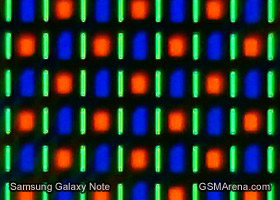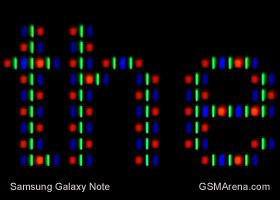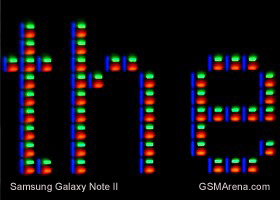Samsung Galaxy Note II N7100 preview: A closer look
A closer look
This article is outdated. We have already published a full review.
Display - PenTile begone
Plenty of people must've been hoping Samsung would fit a non-PenTile screen on the Galaxy Note II and the Koreans delivered. They changed other features of the screen too, like the surface on top, which is now Gorilla Glass 2.
Also, the diagonal grew to 5.55" (up from 5.3") and the aspect ratio changed - the Galaxy Note II uses a 720p screen (16:9) instead of WXGA (16:10).
What this amounts to is a taller, narrower screen (and consequently taller, narrower device) and a slightly increased surface area - the Galaxy Note II screen has about 2% more surface area than the original Note.


The brilliant screen on the Samsung Galaxy Note II
The removal of that 80-pixel wide strip resulted in a slightly lower pixel density - 267ppi vs. 285ppi. The new matrix, however, makes up for that easily and the perceivable sharpness of the screen is actually higher.
It's no longer a PenTile matrix like on the original Note (which had a slight crosshatch patter noticeable, but only if you look really close). Perhaps these photos snapped with a digital microscope will help clear up the differences in pixel arrangements.


Samsung Galaxy Note screen • Samsung Galaxy Note II screen
The pixels of the Note II have one tall Blue sub-pixel on the left and smaller Green and Red pixels stacked one on top of the other. It's an odd arrangement, but it has three subpixels per pixel. The reason for the different Blue pixel size is that Blue AMOLEDs typically have a shorter life and making them bigger balances things out. Being bigger, the Blue pixel doesn't emit as much light, which helps it last longer, but color balance isn't affected (because of its size).
To illustrate how the different arrangement improves sharpness we used our microscope to snap a picture of very small font - the line width here is 1px, the font is white.


Samsung Galaxy Note screen • Samsung Galaxy Note II screen
As you can see, the Galaxy Note II screen lights up individual pixels to display the 1px-wide lines. The old Galaxy Note, however, can't use a single pixel to make white, as it only has two of the three needed colors.
To fix that, the screen uses sub-pixel rendering, which "borrows" a subpixel from a neighboring pixel to make white. But now the line has become 1 2/3px wide.
Another thing we noticed was that the sub-pixels of the new matrix are actually using more of their allotted space and there's less left to be wasted. Notice that the distance between individual pixels is far closer here, compared to the original note and that also improves the image quality.
This new arrangement seems to result in some very slight color aberrations around sharp edges, but it takes a great deal of eye-strain to try and see it.
| Display test | 50% brightness | 100% brightness | ||||
| Black, cd/m2 | White, cd/m2 | Black, cd/m2 | White, cd/m2 | |||
| Samsung Galaxy Nexus | 0 | 112 | ∞ | 0 | 247 | ∞ |
| Samsung I9300 Galaxy S III | 0 | 174 | ∞ | 0 | 330 | ∞ |
| Samsung Galaxy Note II | 0 | 253 | ∞ | 0 | 478 | ∞ |
| HTC One X | 0.15 | 200 | 1375 | 0.39 | 550 | 1410 |
| Sony Xperia S | - | - | - | 0.48 | 495 | 1038 |
| Motorola RAZR XT910 | 0 | 215 | ∞ | 0 | 361 | ∞ |
| Samsung I9100 Galaxy S II | 0 | 231 | ∞ | 0 | 362 | ∞ |
| HTC One S | 0 | 177 | ∞ | 0 | 386 | ∞ |
| Samsung Galaxy Note | 0 | 287 | ∞ | 0 | 429 | ∞ |
| HTC Sensation XE | 0.23 | 172 | 761 | 0.64 | 484 | 752 |
One cool addition to the display settings is that even with Automatic brightness turned on, the brightness slider remains active. This allows you to fine-tune the brightness, but still have it automatically adjust to the ambient light.
Bigger, more comfortable S Pen
The Samsung Galaxy Note II grew in size over the original and so did the new S Pen. The old one is about 10.4cm tall and 5mm thick, while the new one measures 11.3cm in length and 7mm in thickness.



Old and new S Pens side by side
While nowhere near as comfortable as the S Pen on the Galaxy Note 10.1, the one that comes with the Note II feels more like a pen and less than a stylus, compared to the one inside the original Note.
The button on the S Pen now has a ribbed pattern, making it easier to locate by touch (the old one is flat and flush against the surface.
The Galaxy Note II can detect when you pull the S Pen out and brings you to a contextual page, which offers shortcuts (with preview thumbnails) of your recent S Notes.
Since there's no lanyard linking the S Pen and the Galaxy Note II, the phablet uses its accelerometer to detect you walking away and will alert you if the stylus isn't in its slot. The feature won't trigger unless you're several steps away - so you can walk and write without it bothering you, but if you really forgot it and walked away it will start beeping.
The new Samsung Galaxy Note II screen can detect the S Pen from a distance, similar to how the Galaxy Note 10.1 worked. The hover feature, called Air View, is not part of the stylus though, we tested the S Pen from the original Note and it worked just fine.
The Note II also features a more sensitive digitizer compared to the original. It can distinguish between 1024 different levels of pressure (quadruple what the original managed) and you can really feel the difference in the drawing apps - you get fine-grained control between thin and thick lines.
Reader comments
- Shasza
- 07 Oct 2013
- iiH
Great phone...recommend to anyone buying. Although note 3 has come out with bigger and faster features in Sept 2013...Oh well I am not sure how to keep up wth this trend, if they come out with newer models each year. Its soooo crazy....
- sopy
- 05 Aug 2013
- IVI
Y my note 2 always stuck???
- TT
- 25 Jun 2013
- PW6
I have just known,official NoteII N7100 imported to Thailand, it's hardware not support 4G LTE!
